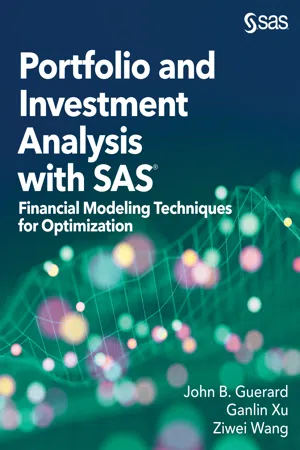
Portfolio and Investment Analysis with SAS
Financial Modeling Techniques for Optimization
- 230 pages
- English
- ePUB (mobile friendly)
- Available on iOS & Android
Portfolio and Investment Analysis with SAS
Financial Modeling Techniques for Optimization
About This Book
Choose statistically significant stock selection models using SAS
Portfolio and Investment Analysis with SAS: Financial Modeling Techniques for Optimization is an introduction to using SAS to choose statistically significant stock selection models, create mean-variance efficient portfolios, and aggressively invest to maximize the geometric mean. Based on the pioneering portfolio selection techniques of Harry Markowitz and others, this book shows that maximizing the geometric mean maximizes the utility of final wealth. The authors draw on decades of experience as teachers and practitioners of financial modeling to bridge the gap between theory and application.
Using real-world data, the book illustrates the concept of risk-return analysis and explains why intelligent investors prefer stocks over bonds. The authors first explain how to build expected return models based on expected earnings data, valuation ratios, and past stock price performance using PROC ROBUSTREG. They then show how to construct and manage portfolios by combining the expected return and risk models. Finally, readers learn how to perform hypothesis testing using Bayesian methods to add confidence when data mining from large financial databases.
Frequently asked questions
Information
1.1 Introduction

Table of contents
- Cover
- Copyright Page
- Contents
- About This Book
- Chapter 1: Why Do We Invest?
- Chapter 2: An Introduction to Financial Statement Analysis
- Chapter 3: The Risk and Return of Equity and the Capital Asset Pricing Model
- Chapter 4: Robust Regression and Stock Selection in Global Equity Markets
- Chapter 5: The Theory of Risk, Return, and Performance Measurement
- Chapter 6: Data Mining Corrections
- Chapter 7: Summary and Conclusions
- References